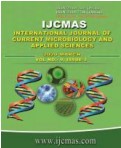


 National Academy of Agricultural Sciences (NAAS)
National Academy of Agricultural Sciences (NAAS)

|
PRINT ISSN : 2319-7692
Online ISSN : 2319-7706 Issues : 12 per year Publisher : Excellent Publishers Email : editorijcmas@gmail.com / submit@ijcmas.com Editor-in-chief: Dr.M.Prakash Index Copernicus ICV 2018: 95.39 NAAS RATING 2020: 5.38 |
The present study was undertaken to know the clinical, haemato-biochemical and therapeutic management of anaplasmosis in bovines. A total of 150 animals showing signs of tick infestation, anorexia, jaundice, anaemia with varied pyrexia were included in the present study. Around 5ml blood was collected from jugular vein aspectically for haemato-biochemical estimation. For therapeutic study, Twelve anaplasmosis affected animals were randomly selected and divided into two groups consisting of six animals in each group. Animals in group I were treated with Oxytetracycline hydrochloride @ 20 mg/kg body weight intravenously in normal saline daily for 5 consecutive days along with supportive therapy whereas, animals of group II were given Imidocarb dipropionate @ 5 mg/kg body weight deep intramuscularly as a single dose. Partial to complete anorexia, high fever (104 to 106 ËšF), anaemia, jaundice, debility, decrease in milk yield, hurried respiratory rate, tachycardia and presence of ticks on the body were the consistent clinical signs shown by the affected animals. There was a significant reduction (P<0.05)in the haemoglobin, packed cell volume, total erythrocyte count of affected animals on day 0 as compared to healthy control group. Biochemical examination revealed significant elevation(P<0.05) of SGOT, SGPT and total bilirubin concentration on day 0 as compared to the animals of control group. Among Group I animals treated with Oxytetracycline, five animals recovered completely suggestive of 83.33 per cent efficacy whereas, all animals of Group II (06) treated with Imidocarb dipropionate recovered completely by seventh day with cent per cent efficacy rate.
 |
 |
 |
 |
 |